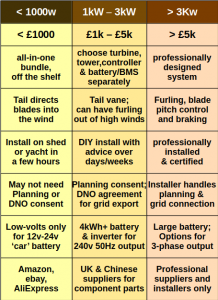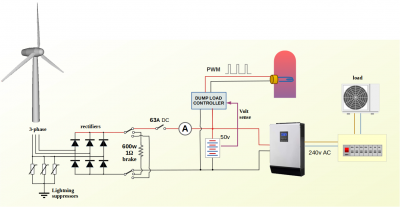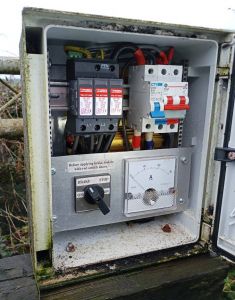Wind turbines, planning applications and implementation
May I intervene?
I think we're not comparing similar products.
I see the wind-turbine market in three quite different categories:
I think @toodles is describing wind-turbines in the first column.
They spin quite fast and are regularly touted online.
You often see them on YouTube, sometimes accompanied by extravagant claims after only a few days of use!
@knukes is far into the 3rd column.
When the wind-turbine itself is costing £38k then you really do need a professional company who know what they're doing.
I'm in the middle column.
And I'll suggest that's where @blott is likely to end up too.
There will be others reading this topic in months/years to come who would like to have a wind-turbine which produces enough output to be of use in the home, but their site isn't optimal or they're not prepared to take the risk of spending a lot of money. If there's genuine interest from others who'd like to dabble in the level of output which I've experienced (1kW - 2kW) then I can provide more details.
But it's a wide topic, and it would be best if I was answering specific questions.
Save energy... recycle electrons!
@transparent Yes, was definitely a professional install using a company called SWTCo Ltd who are specialists in installing and repairing wind turbines. I’d highly recommend them.
Something worth mentioning is that some turbines come under permitted development so don’t need planning permission as long as these conditions are met https://www.planningportal.co.uk/permission/common-projects/wind-turbines/planning-permission-stand-alone-wind-turbines
I think the SD3 from SD Wind complies for example.
Weirdly, you need planning permission if you have an ASHP though, which is why we had to go down that difficult and costly route.
I've just checked their website @knukes so I'm providing the link for SWTCo Ltd based the the Midlands.
Tom Hodkinson, the CEO, is installing one of the best-designed turbines ever produced - the Proven range from SD Wind in Scotland.
So I'm unsurprised that you're delighted with the 6kW SD6 variant. 😎
I was extremely disappointed when the original Proven company failed.
They were pushing the UK designed/manufactured market, pretty much on their own.
However, they experienced mechanical failure on a larger model they were developing, and it was enough to tip the company over the brink.
If they'd been anywhere but the UK, then I think government would've stepped in to ensure that they survived intact.
Save energy... recycle electrons!
@transparent I am only interested in a vertical turbine, fixed to my wall i.e. not stand-alone, to top up my PV system batteries in winter/cloudy weather. Any ideas on reliable manufacturers/data would be appreciated. Thanks. I would install the turbine myself.
I too would like a small, 0.5 to 1Kw vertical axis wind turbine to go at the bottom of the garden and basically top up the battery we have in the house during the windy, dark days of winter. Maybe in a couple of years time, the case for one is quite strong, since you could easily get 10 to 20 KwHr in a day given the weather we have around here. That would be a useful contribution to our electricity use at that time of year.
Responding to both @blott and @guthrie...
I'm unable to comment on the different types of vertical turbine.
Although I've read extensively about the different design approaches, I haven't compared their efficiencies or reliability.
However, I do need to provide some insights into the safety and control gear which you need to adopt for a mid-range turbine for self-install.
This is a generic diagram of the main devices you'd expect to see for a domestic turbine installation:
Note that I've placed the (rectified) output of the turbine PMG directly across the storage battery.
That automatically provides the output regulation.
Once the turbine output exceeds the battery voltage, then it will charge.
Simples!
The controller in this diagram is installed as a dump-load controller.
It has been configured with the parameters required for that particular battery.
As the battery reaches capacity, the voltage rises and the controller changes the PWM output to a dump-load (an immersion heater in this case).
In practice you will divide the components between the base of the tower and the 'cupboard' adjacent to your battery.
You'll need the capability to isolate devices for maintenance at each end of the main feed cable.
Here's a photo of the actual arrangement in the weather-proof enclosure at my tower.
These coarse (first stage) suppressors will throw any lightning strike to ground rather than allow it to pass along the thick copper wires into my home!
The back-panel is 8mm thick aluminium.
Bolted onto it are the three rectifier assemblies and the large resistors which operate as a brake.
That allows me to bring the turbine to a halt before placing a dead-short across the output of the rectifiers.
It will them be safe to lower the tower and undertake any maintenance.
The next photo shows my TriStar Load Controller, inverter etc within the battery cupboard.
This dates from a time before I changed to use LiFePO4 chemistry.
The TriStar 60A unit is a high-spec and effective controller.
But I wouldn't be using that approach now.
Electronics has moved on significantly.
I would now build my own bespoke Load Controller using an Arduino and some hefty mosFET switching to supply a dump-load.
A logic-level mosFET rated at 55v, 40A costs less than £1
You will also notice a fast-acting low-level anti-surge device, next to the analogue voltage meter.
That's connected to the same earth reference as the rest of the house mains electricity circuits.
Up until that point, every part of the turbine electronics is effectively 'floating'.
Save energy... recycle electrons!
@transparent Many thanks for your insight and the schematics. Any vertical turbine I decide on, won't be above 1st floor level, so thankfully lightning strikes won't be a likely problem. Much food for thought! Thanks again for your input.
- 22 Forums
- 2,097 Topics
- 46.2 K Posts
- 48 Online
- 3,385 Members
Join Us!
Latest Posts
-
RE: Ecodan consuming 100kwh per day in new build!!!
Hmm Before doing that I would want to be certain that...
By JamesPa , 4 hours ago
-

RE: 5 Star Service from Havenwise
That's always a danger with any new good idea, @morgan....
By Majordennisbloodnok , 4 hours ago
-

RE: Heat pump solutions and/or installer recommendations for France
Sorry Bravo. I have no installer contacts outside the U...
By Mars , 14 hours ago
-

Have your say in the Renewable Heating Hub Awards
It’s time to celebrate the best (and call out the worst...
By Mars , 15 hours ago
-

-

RE: Mitsubishi cycling while on chilled water output
@iaack yes there's no denying that cold air sinks! I s...
By downfield , 23 hours ago
-

RE: Weather compensated secondary circuits with Biomass
@andycoo that flooring sounds ideal. Extra volume is ...
By Sune , 1 day ago
-
If you are thinking of heating on the immersion conside...
By JamesPa , 2 days ago
-

RE: Surface mount or bury primaries for heat pump installation?
@tomasmcguinness, I think your best bet would be using ...
By Aventus Eco , 3 days ago
-
RE: Solar Power Output – Let’s Compare Generation Figures
@toodles all depends on asking the right questions! And...
By Tim441 , 3 days ago
-
RE: Commencing on an ASHP Installation Process
I received confirmation this morning that my Greener Ho...
By Sheriff Fatman , 3 days ago
-
@jamespa Thanks for the advice - very helpful. I had al...
By abam48 , 4 days ago
-

RE: Adding battery storage to SolarEdge PV system
@chandykris No need to apologise at all! I forgot to ad...
By Toodles , 5 days ago
-
RE: Say hello and introduce yourself
Yes please do Suggesting a loss in the region...
By JamesPa , 5 days ago






